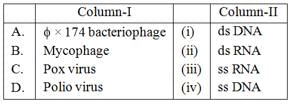Class 11 Exam > Class 11 Tests > Test: Virus - Class 11 MCQ
Test: Virus - Class 11 MCQ
Test Description
30 Questions MCQ Test - Test: Virus
Test: Virus for Class 11 2024 is part of Class 11 preparation. The Test: Virus questions and answers have been prepared
according to the Class 11 exam syllabus.The Test: Virus MCQs are made for Class 11 2024 Exam.
Find important definitions, questions, notes, meanings, examples, exercises, MCQs and online tests for Test: Virus below.
Solutions of Test: Virus questions in English are available as part of our course for Class 11 & Test: Virus solutions in
Hindi for Class 11 course.
Download more important topics, notes, lectures and mock test series for Class 11 Exam by signing up for free. Attempt Test: Virus | 60 questions in 60 minutes | Mock test for Class 11 preparation | Free important questions MCQ to study for Class 11 Exam | Download free PDF with solutions
Detailed Solution for Test: Virus - Question 1
Detailed Solution for Test: Virus - Question 2
| 1 Crore+ students have signed up on EduRev. Have you? Download the App |
Detailed Solution for Test: Virus - Question 3
Detailed Solution for Test: Virus - Question 4
Detailed Solution for Test: Virus - Question 5
Detailed Solution for Test: Virus - Question 6
Detailed Solution for Test: Virus - Question 7
Detailed Solution for Test: Virus - Question 8
Detailed Solution for Test: Virus - Question 9
Test: Virus - Question 10
Which resistant proteins are formed in an eukaryotic cell due to virus infection : -
Detailed Solution for Test: Virus - Question 10
Detailed Solution for Test: Virus - Question 11
Detailed Solution for Test: Virus - Question 12
Detailed Solution for Test: Virus - Question 13
Detailed Solution for Test: Virus - Question 14
Detailed Solution for Test: Virus - Question 15
Test: Virus - Question 16
Match the column-I with column-II & choose the correct answer option : -

Detailed Solution for Test: Virus - Question 16
Detailed Solution for Test: Virus - Question 17
Detailed Solution for Test: Virus - Question 18
Detailed Solution for Test: Virus - Question 19
Detailed Solution for Test: Virus - Question 20
Detailed Solution for Test: Virus - Question 21
Detailed Solution for Test: Virus - Question 22
Detailed Solution for Test: Virus - Question 23
Test: Virus - Question 24
A phage that invades attacks in a host cell but does not destory it, is know as : -
Detailed Solution for Test: Virus - Question 24
Detailed Solution for Test: Virus - Question 25
Test: Virus - Question 26
Which of the following characters justify the living nature of viruses : -
Detailed Solution for Test: Virus - Question 26
Detailed Solution for Test: Virus - Question 27
Detailed Solution for Test: Virus - Question 28
Test: Virus - Question 29
Which of the following is devoid of protein coat and entirely composed of RNA only : -
Detailed Solution for Test: Virus - Question 29
Detailed Solution for Test: Virus - Question 30
View more questions
Information about Test: Virus Page
In this test you can find the Exam questions for Test: Virus solved & explained in the simplest way possible.
Besides giving Questions and answers for Test: Virus, EduRev gives you an ample number of Online tests for practice
Download as PDF


















